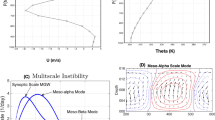Abstract
This paper builds on recent developments of a unified asymptotic approach to meteorological modeling [ZAMM, 80: 765–777, 2000, SIAM Proc. App. Math. 116, 227–289, 2004], which was used successfully in the development of Systematic multiscale models for the tropics in Majda and Klein [J. Atmosph. Sci. 60: 393–408, 2003] and Majda and Biello [PNAS, 101: 4736–4741, 2004]. Biello and Majda [J. Atmosph. Sci. 62: 1694–1720, 2005]. Here we account for typical bulk microphysics parameterizations of moist processes within this framework. The key steps are careful nondimensionalization of the bulk microphysics equations and the choice of appropriate distinguished limits for the various nondimensional small parameters that appear. We are then in a position to study scale interactions in the atmosphere involving moist physics. We demonstrate this by developing two systematic multiscale models that are motivated by our interest in mesoscale organized convection. The emphasis here is on multiple length scales but common time scales. The first of these models describes the short-time evolution of slender, deep convective hot towers with horizontal scale ~ 1 km interacting with the linearized momentum balance on length and time scales of (10 km/3 min). We expect this model to describe how convective inhibition may be overcome near the surface, how the onset of deep convection triggers convective-scale gravity waves, and that it will also yield new insight into how such local convective events may conspire to create larger-scale strong storms. The second model addresses the next larger range of length and time scales (10 km, 100 km, and 20 min) and exhibits mathematical features that are strongly reminiscent of mesoscale organized convection. In both cases, the asymptotic analysis reveals how the stiffness of condensation/evaporation processes induces highly nonlinear dynamics. Besides providing new theoretical insights, the derived models may also serve as a theoretical devices for analyzing and interpreting the results of complex moist process model simulations, and they may stimulate the development of new, theoretically grounded sub-grid-scale parameterizations.
Similar content being viewed by others
References
Bannon P.R. (1995): Potential vorticity conservation, hydrostatic adjustment, and the anelastic approximation. J. Atmos. Sci.52, 2302–2312
Biello J.A., Majda A.J. (2005): A new multiscale model for the Madden Julian oscillation. J. Atmosph. Sci. 62, 1694–1720
Botta N., Klein R., Almgren A. (1999): Asymptotic analysis of a dry atmosphere, ENUMATH Jyväskylä, Finland
Botta, N., Klein, R., Almgren, A.: Dry Atmosphere Asymptotics, PIK Report 55, Potsdam Institut für Klimafolgenforschung (1999)
Clark T.L. (1977): A small-scale dynamic model using a terrain following coordinate transformation. J. Comp. Phys. 24, 186–215
Emanuel, K. A.: Atmospheric Convection, Oxford University Press (1994)
Ghan S., Randall D., Xu K., Cederwall R., Cripe D., Hack J., Iacobellis S., Klein S., Krueger S., Lohmann U., Pedretti J., Robock A., Rotstayn L., Somerville R., Stenchikov G., Sud Y., Walker G., Xie S., Yio J., Zhang M. (2000): A comparison of single column model simulations of summertime midlatitude continental convection. J. Geophys. Res. 105, 2091–2124
Grabowski W.W. (1998): Toward cloud resolving modeling of large-scale tropical circulations: a simple cloud Microphysics parameterization. J. Atmosph. Sci. 55, 3283–3298
Grabowski W.W., Smolarkiewicz P.K. (1990): Monotone finite-difference approximations to the advection-condensation problem. Mon. Wea. Rev. 118, 2082–2097
Grabowski W.W., Smolarkiewicz P.K. (1996): On two-time semi-Lagrangian modelling of precipitating clouds. Mon. Wea. Rev. 124, 487–497
Grabowski W.W. (2002): Large-scale organization of moist convection in idealized aquaplanet simulations. Int. J. Num. Meth. Fluids 39, 843–853
Kessler E.(1969): On the distribution and continuity of water substance in atmospheric circulations. Meteor. Monographs 32, 84
Klein R. (2000): Asymptotic analyses for atmospheric flows and the construction of asymptotically adaptive numerical methods. ZAMM, 80, 765–777
Klein R. (2004): An applied mathematical view of theoretical meteorology, invited presentation at ICIAM 2003, Sydney, Australia. SIAM Proc. Appl. Math.116, 227–289
Klein R. (2004): Multiple Scales Asymptotics for Atmospheric Flows, 4th European Conference on Mathematics, Stockholm, Sweden
Lipps F.B., Hemler R.S. (1982): A scale analysis of deep moist convection and some related numerical simulations. J. Atmos. Sci.39, 2192–2210
Majda A.J., Klein R. (2003): Systematic multi-scale models for the tropics. J. Atmosph. Sci. 60, 393–408
Majda A.J., Biello J.A. (2004): A multiscale model for tropical intraseasonal oscillations. PNAS 101, 4736–4741
Moncrieff M.W.(1981): A theory of organized steady convection and its transport properties. Q. J. R. Meteor. Soc. 107, 29–50
Moncrieff M.W. (1992): Organized convective systems: archetypal dynamical models, mass and momentum flux theory, and parameterization. Q. J. R. Meteor. Soc. 118, 819–850
Pandya E.R., Durran D.R. (1996): The influence of convectively generated thermal forcing on mesoscale circulation around squall lines. J. Atmosph. Sci. 53, 2924–2951
Parkins C.J, Blythe P.A., Crighton D.G. (2000): Hot spot ignition: the Newtonian limit. Proc. R. Soc. Phys. Eng. Sci. 456, 2857–2882
Pedlosky J. (1987): Geophysical Fluid Dynamics. 2nd edn. Springer, Berlin Heidelberg New York
Peters N. (2000): Turbulent Combustion. Cambridge University Press, Cambridge
Wacker, U.: private communication with Dr. Ulrike Wacker, Alfred Wegener Institut für Polar- und Meeresforschung, Bremerhaven, Germany (2005)
Author information
Authors and Affiliations
Corresponding author
Additional information
Communicated by R. Grimshaw
Rights and permissions
About this article
Cite this article
Klein, R., Majda, A.J. Systematic multiscale models for deep convection on mesoscales. Theor. Comput. Fluid Dyn. 20, 525–551 (2006). https://doi.org/10.1007/s00162-006-0027-9
Received:
Accepted:
Published:
Issue Date:
DOI: https://doi.org/10.1007/s00162-006-0027-9



